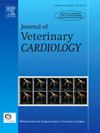猫室间隔缺损的外科矫正
IF 1.3
2区 农林科学
Q2 VETERINARY SCIENCES
引用次数: 0
摘要
一只两岁的完整雄性英国短毛猫,体重4.6公斤,被转诊为室间隔缺损(VSD)的手术矫正。用哌莫苯丹、氨氯地平、呋塞米和氯吡格雷治疗猫呼吸急促,未观察到其他心脏疾病的临床症状。体检发现心脏杂音。x线和超声心动图评价显示广泛性心脏增大和左房增大。二维超声心动图显示一个巨大的左至右分流通过5.8毫米膜周室间隔动脉瘤。肺-全身血流量比为3.3,表明明显的容量过载。在体外循环下通过右心室流出道切口进行手术矫正,使用8mm膨胀聚四氟乙烯贴片关闭室间隔。术后,猫有散发性室性早搏,但恢复无主要并发症。术后一年,猫表现出改善的活动水平,没有残留的分流流,不需要药物治疗。本报告证明了通过右心室流出道切口膜片闭合治疗猫膜性室间隔缺损的可行性,并强调了进一步研究评估其有效性的必要性。本文章由计算机程序翻译,如有差异,请以英文原文为准。
Surgical correction of ventricular septal defect in a cat
A two-year-old intact male British shorthair cat, weighing 4.6 kg, was referred for surgical correction of a ventricular septal defect (VSD). The cat was treated with pimobendan, amlodipine, furosemide, and clopidogrel for tachypnea, and no other clinical signs of cardiac disease were observed. Physical examination revealed heart murmurs. Radiographic and echocardiographic evaluations indicated generalized cardiomegaly and left atrial enlargement. Two-dimensional echocardiography revealed a large left-to-right shunt through a 5.8-mm perimembranous VSD with a septal aneurysm. The pulmonary-to-systemic blood flow ratio was 3.3, indicating a significant volume overload. Surgical correction was performed via a right ventricular outflow tract incision under cardiopulmonary bypass using an 8-mm expanded polytetrafluoroethylene patch to close the VSD. Postoperatively, the cat had sporadic premature ventricular contractions but recovered without major complications. At one year postoperatively, the cat showed improved activity levels and no residual shunt flow and required no medication. This report demonstrates the feasibility of patch closure for membranous VSDs in cats through a right ventricular outflow tract incision and highlights the need for further studies to assess its effectiveness.
求助全文
通过发布文献求助,成功后即可免费获取论文全文。
去求助
来源期刊

Journal of Veterinary Cardiology
VETERINARY SCIENCES-
CiteScore
2.50
自引率
25.00%
发文量
66
审稿时长
154 days
期刊介绍:
The mission of the Journal of Veterinary Cardiology is to publish peer-reviewed reports of the highest quality that promote greater understanding of cardiovascular disease, and enhance the health and well being of animals and humans. The Journal of Veterinary Cardiology publishes original contributions involving research and clinical practice that include prospective and retrospective studies, clinical trials, epidemiology, observational studies, and advances in applied and basic research.
The Journal invites submission of original manuscripts. Specific content areas of interest include heart failure, arrhythmias, congenital heart disease, cardiovascular medicine, surgery, hypertension, health outcomes research, diagnostic imaging, interventional techniques, genetics, molecular cardiology, and cardiovascular pathology, pharmacology, and toxicology.
 求助内容:
求助内容: 应助结果提醒方式:
应助结果提醒方式:


